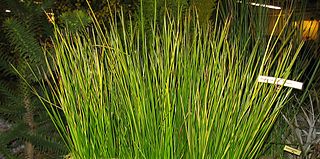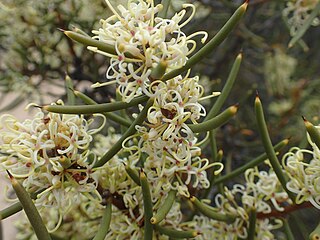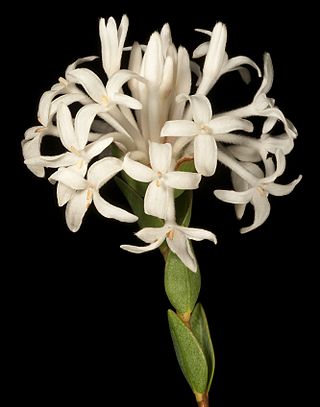Banksia acuminata is a rare prostrate shrub endemic to south-west Western Australia. It was published in 1848 as Dryandra preissii, but transferred into Banksia as B. acuminata in 2007.

Grevillea preissii is a species of flowering plant in the family Proteaceae and is endemic to the southwest of Western Australia. It is a mounded to spreading or dense, erect shrub, the leaves divided with 5 to 7 linear to more or less cylindrical lobes, and groups of reddish flowers arranged along one side of the flowering rachis.

Callitris preissii is a species of conifer in the family Cupressaceae, endemic to Rottnest Island, Australia. Common names include Rottnest Island pine, Murray pine, maroong, southern cypress pine, and slender cypress pine. The Noongar peoples know the tree as marro.

Xanthorrhoea preissii, known as balga, is a widespread species of perennial monocot in Southwest Australia.

Baumea is a genus of the sedge family, which includes around 30 species native to Madagascar and the Pacific Islands, with 15 species in Australia. All are perennial rhizomatous herbs, with leaves and stems very similar in appearance. The inflorescence is terminal, with the flowers tightly clustered or loosely arranged. The fruits are small nuts.

Calothamnus preissii is a plant in the myrtle family, Myrtaceae and is endemic to the south-west of Western Australia. It is a low-lying, sometimes ground-hugging shrub with needle-like leaves and reddish-purple flowers in spring.

Hakea preissii, commonly known as the needle tree, needle bush and Christmas hakea, is a shrub or tree of the genus Hakea native to Western Australia. The Noongar name for the plant is Tanjinn.

Eucalyptus lane-poolei, commonly known as salmon white gum, is a species of tree or mallee that is endemic to Western Australia. It has smooth but scaly-looking bark, narrow lance-shaped or curved adult leaves, flower buds in groups of seven, creamy white flowers and hemispherical fruit.
Wahlenbergia preissii is a small herbaceous plant in the family Campanulaceae native to Western Australia.

Baumea acuta, commonly known as pale twig-rush, is a flowering plant in the sedge family, Cyperaceae, that is native to southern parts of Australia.
Baumea arthrophylla(now known as Machaerina arthrophylla) is a flowering plant in the sedge family, Cyperaceae that is native to many states and territories of Australia.

Machaerina juncea, commonly known as bare twig-rush or tussock swamp twig rush, is a sedge in the sedge family, Cyperaceae, that is native to Australia, New Zealand, and New Caledonia.

Machaerina rubiginosa, commonly known as soft twig rush, flat leaf twig rush or common twig rush, is a flowering plant in the sedge family, Cyperaceae, that is native to Asia and the Pacific.
Baumea vaginalis, commonly known as sheath twig rush, is a flowering plant in the sedge family, Cyperaceae, that is native to Western Australia.
Bossiaea preissii is a species of flowering plant in the family Fabaceae and is endemic to the south of Western Australia. It is a compact, glabrous shrub with egg-shaped leaves with the narrower end towards the base, and yellow, red, orange or apricot-coloured flowers.

Gompholobium preissii is a species of flowering plant in the family Fabaceae and is endemic to the south-west of Western Australia. It is an erect shrub with pinnate leaves with five to fifteen leaflets, and yellow, red and orange, pea-like flowers.

Brachyloma preissii is a species of flowering plant in the heath family, Ericaceae, and is endemic to Western Australia. It is an erect, dense shrub with linear to oblong leaves and red, or pinkish-red, tube-shaped flowers.

Daviesia preissii is a species of flowering plant in the family Fabaceae and is endemic to the south-west of Western Australia. It is a glabrous shrub with scattered, vertically flattened, tapering, narrowly egg-shaped to elliptic, sharply-pointed phyllodes and yellow and red flowers.

Conostephium preissii is a species of flowering plant in the family Ericaceae and is endemic to the southwest of Western Australia. It is an erect shrub with many stems, egg-shaped to oblong leaves and white and purplish to reddish-pink flowers.

Pimelea preissii is a species of flowering plant in the family Thymelaeaceae and is endemic to the southwest of Western Australia. It is an erect, spreading shrub with narrowly elliptic leaves arranged in opposite pairs, and compact clusters of many white or pink flowers surrounded by 4 green, egg-shaped involucral bracts.













